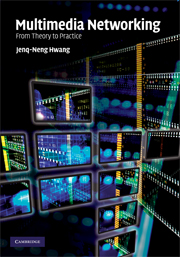Book contents
- Frontmatter
- Contents
- Preface
- Acknowledgements
- List of abbreviations
- 1 Introduction to multimedia networking
- 2 Digital speech coding
- 3 Digital audio coding
- 4 Digital image coding
- 5 Digital video coding
- 6 Digital multimedia broadcasting
- 7 Multimedia quality of service of IP networks
- 8 Quality of service issues in streaming architectures
- 9 Wireless broadband and quality of service
- 10 Multimedia over wireless broadband
- 11 Digital rights management of multimedia
- 12 Implementations of multimedia networking
- Index
8 - Quality of service issues in streaming architectures
Published online by Cambridge University Press: 26 January 2010
- Frontmatter
- Contents
- Preface
- Acknowledgements
- List of abbreviations
- 1 Introduction to multimedia networking
- 2 Digital speech coding
- 3 Digital audio coding
- 4 Digital image coding
- 5 Digital video coding
- 6 Digital multimedia broadcasting
- 7 Multimedia quality of service of IP networks
- 8 Quality of service issues in streaming architectures
- 9 Wireless broadband and quality of service
- 10 Multimedia over wireless broadband
- 11 Digital rights management of multimedia
- 12 Implementations of multimedia networking
- Index
Summary
With the fast advances in computing and compression technologies, high-bandwidth storage devices, and high-speed networks, it is now feasible to provide real-time multimedia services over the Internet. This is evident from the popular use of the three most commonly used streaming media systems, i.e., Microsoft's Windows Media [1], RealNetwork's RealPlayer [2], and Apple's QuickTime [3]. The real-time transport of live or stored audio and video is the predominant part of real-time multimedia. In the download mode of multimedia transport over the Internet, a user downloads the entire audio/video file and then plays back the media file. However, full file transfer in the download mode usually suffers long and perhaps unacceptable transfer times. In contrast, in the streaming mode the audio and video content need not be downloaded in full but is being played out while parts of the content are being received and decoded. Multimedia streaming is an important component of many Internet applications such as distance learning, digital libraries, video conferencing, home shopping, and video-on-demand. The best-effort nature of the current Internet poses many challenges to the design of streaming video systems. Owing to its real-time nature, audio and video streaming typically has bandwidth, delay, and loss requirements. However, the current best-effort Internet does not offer any quality of service (QoS) guarantees to streaming media over the Internet.
The design of some early streaming media programs, such as VivoActive 1.0 [4], was based on the use of the H.263 video and G.723 audio protocols, with HTTP-based web servers, to deliver encoded media content.
Information
- Type
- Chapter
- Information
- Multimedia NetworkingFrom Theory to Practice, pp. 257 - 300Publisher: Cambridge University PressPrint publication year: 2009
